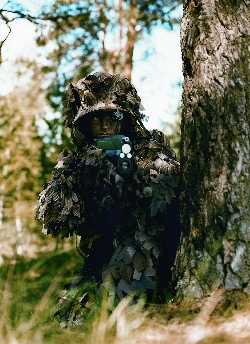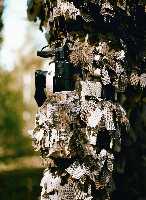Soldiers Modernize Beneath Northern Lights
 |
Signature management technologies have been used to develop the Saab Warrior from its inception. While the combat attire will be worn in moderate temperatures, the equipment also must be able to withstand temperatures close to 50 degrees below zero in Sweden's Arctic North region. |
The Swedish military is preparing the way for fielding its own soldier modernization program by 2010 with field trials beginning this year. In support of the effort, one company is developing its own soldier ensemble to meet Swedish requirements and to compete in the international market at both the system-of-systems and subsystems levels.
Sweden pursued its own path in defense procurement and development throughout the Cold War, keeping pace with the latest defense technology in military and industrial terms while remaining strictly nonaligned. Industrial consolidation in Sweden with the acquisition of Celsius by Saab, Linkoping, Sweden, was the catalyst for development of the Saab Warrior soldier ensemble.
The country recently conducted a land components combat-equipped soldier study called MARKUS. Keeping that study in mind, Saab is developing a design to meet the military’s requirements. According to Per Hoving, program manager for Saab Warrior at the firm, this provides a unified capability under one roof that could furnish both the architecture and a complete suite of subsystems necessary for soldier modernization. Work on the project began in 2000.
Hoving explains that a system-of-systems approach is being adopted that will function independently of whatever national or proprietary systems are integrated at the subsystems level, such as night vision systems, navigation systems, radio frequency communications, and command and control (C2) infrastructure. This core architecture will tie the components together by defining how information is exchanged.
He contrasts this approach with traditional design concepts where components are hardwired together at a lower level. “The difference in the system-of-systems level is that we have gone a few steps up the architecture ladder and have standardized how any subsystem communicates with the core, and through the core to communicate to any other suitable system.” Whether that information is transported with or without wires is not important to this core architecture, he explains. This is achieved by fitting core architecture interface modules to subsystem devices, which will then function as the “mailboxes” for the information being transmitted.
Saab is in the process of implementing individual soldier prototypes of the core architecture for demonstration in early 2004. These demonstrations will enable the system to be used by two or more soldiers. Demonstrating the architecture to the military customer also will require applications, and Saab is now considering which applications to include in the prototype, with C2 being an obvious choice. “A customer from the defense community wants to see something that is more closely related to what the soldier system is supposed to do,” Hoving notes.
Saab will reap a number of benefits from investing in such a project, Hoving points out. “Typically, in the defense business, you have to have a request from a procurement agency before you act. We believe that by entering voluntarily into soldier modernization program development, we would perform better in future competitions. We would have much more freedom of thought in developing our concept so we could be an intelligent and enlightened party when entering into discussions related to different programs in Sweden and elsewhere,” he states.
“On a systems level, we have not started an international marketing effort. We are focusing on the domestic market as the first priority. But of course we have a perspective,” Hoving adds. He categorizes the soldier modernization program market in different ways. One market segment includes those countries with large, national programs like France, Germany, the United Kingdom and the United States, where Saab would compete against domestic and other international sources to supply subsystems. Another segment comprises the majority of customers who want to buy products off the shelf. In addition, although the military customer is the first priority, Saab also sees potential to offer this architecture and related subsystems as a solution for emergency services.
 |
The Saab Warrior's Design employs a core communications architecture that is being developed to integrate the subsystems the military requires. However, other potential customers include emergency services personnel. |
“The majority of countries will be open to Saab Warrior and systems coming out of other projects such as Land Warrior. We will be able to compete at a systems level in countries that do not have a national program,” Hoving relates. “The same is true of Sweden. It is wrong to believe that we can win everything everywhere—quite the contrary. But through our architecture, we will be able to provide the customer with the possibility to include, in the package for MARKUS, systems that do not originate in Saab.
“We began with a wide and open concept that we believe will be able to house the MARKUS requirements without having to start over on the design level. We already try to mirror the developing requirements from the MARKUS study group. We are catering to that. So far, we have been successful in doing so, and we are confident of doing that when the requirement is finalized,” he adds.
MARKUS began life as a feasibility study in 1999. In 2002, it transitioned to a more formal study, scheduled to last four years. This study was undertaken at a joint level by Sweden’s Defense Materiel Administration, Stockholm, Sweden, and the Swedish armed forces to understand the detailed requirements and needs of a soldier modernization program.
The past year has been used to explore the metrics for the field trials, planned for this year. In these preliminary efforts, components have been tested, but only independently of a soldier modernization program ensemble. The MARKUS group reports annually on its findings and recommendations as requirements evolve.
Field trials will continue until 2006. At that point, a decision will be made on whether to transition to formal procurement with the goal of fielding a MARKUS-equipped unit in 2010 in line with Sweden’s wider requirements for network-centric defense capabilities. This will be followed by incremental improvements to the ensemble’s capabilities.
Sweden is not ignoring work by the NATO Army Armaments Group Topical Group 1 on soldier system interoperability. According to Mårten Lindgren, program manager for the MARKUS study at the Defense Materiel Administration, who is working on the MARKUS study, MARKUS explores the NATO common areas for soldier modernization programs, but its concept is based on Swedish military strategic doctrine. It is an integral part of Sweden’s wider work on network-centric capabilities for its armed forces called network-based defense. Lindgren describes it as a wireless node in the network-centric warfare communications network.
The MARKUS study is tasked with providing demonstrator systems to Sweden’s two major network-centric experiments in DEMO 2005 and DEMO 2006. They will be used to understand and develop the requirements for comprehensive national and joint defense communications from the highest level down to the individual soldier and the sensor-to-shooter relationships and capabilities this makes possible. Sweden currently is working with a number of U.S. companies in the area of network-centric concepts with formal agreements between the U.S. and Swedish governments to work together in this area already established.
While network-based defense is the future, MARKUS also is addressing more traditional concerns. Overload is always a problem for the soldier—modernized or not. The MARKUS study has identified a limit to the weight of equipment a soldier can carry—25 percent of an individual’s own weight. For example, a soldier who weighs 175 pounds can have a combat weight of no more than approximately 220 pounds. This overload problem is exacerbated by the need to operate in Sweden’s Arctic North, which requires the soldier to be able to fight in more than 3 feet of snow in temperatures that drop down to 49 degrees below zero. Hoving succinctly sums these requirements up as “snow, ice, low temperatures and frustrated soldiers who have an acute need to keep warm.”
Under these conditions, batteries—particularly rechargeable cells—perform poorly, and display technologies—particularly touch screens—struggle. This may necessitate that MARKUS rely more heavily on traditional maps. In addition, in most of these types of locations, roads are sparse, and dense forests mean that vehicles operate with great difficulty. The soldier is typically dismounted, wearing heavier winter clothing, and often uses skis. Combat rescue also largely will rely on soldiers lifting their incapacitated comrades to safety.
The Swedish armed forces currently inducts 15,000 to 18,000 new soldiers each year, so MARKUS must design requirements for the 75th percentile of conscripts, who are increasingly heavier but less muscular. Also, Sweden’s goal for its armed forces is to have women compose 30 percent of soldiers and 10 percent of officers. Addressing the issue of training recruits to operate soldier modernization program equipment would require “a simple user interface for conscript soldiers with a short time for training,” Lindgren says.
While the Saab Warrior concept examines the overseas modernization market, Swedish procurement organizations will consider overseas sources to meet their own requirements. “At this time, there are no contracted industrial partners. Today, the project is in a study phase. When it is time to procure the final system, we act on the Public Procurement Act, which applies to all public organizations and does not exclude international partners,” Lindgren relates. There has been ongoing work between Sweden and its Nordic neighbors in this area through the Nordic Armaments Cooperation agreement, he adds.
Saab does not see international interoperability, at least at the technical level, as a challenge. Hoving says that industry would be able to solve this problem cost-effectively over time. “That is not the problem. The problem is, and will be for quite some time, on the doctrinal level. Soldiers will not fight together if they have not trained together. When you are in close combat, you have to know exactly how your fellow soldiers will react. You have to be very sure they will not misinterpret what you say. That would be the discriminator in returning alive or not. There will be interoperability at the technology level, but will there be interoperability on the doctrinal level? That is the question,” he states.
Adam Baddeley is a freelance technical writer based in the United Kingdom. He specializes in the area of command, control, communications, intelligence, surveillance, target acquisition and reconnaissance.




Comments